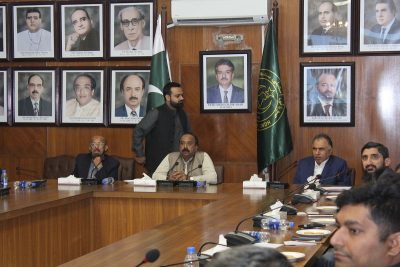
The Pakistan Institute for Parliamentary Services (PIPS) successfully held a Digital Democracy Workshop at the Provincial Assembly of Sindh on January 8, 2025. This event underscored PIPS’ dedication to equipping parliamentary officers with the skills and knowledge required to address the complexities of the digital age. Building on the model used in prior workshops for members of the Sindh and Khyber Pakhtunkhwa assemblies, this session specifically targeted parliamentary officers, with active participation from senior and mid-level officers in grades 17 to 20.
The workshop was facilitated by Mr. Fayaz Thaheem, Deputy Director (PDP), PIPS, and Mr. Usman Zafar, Safe Digital Environment Specialist from UNDP. It aimed at tackling misinformation and disinformation while teaching participants how to utilize digital tools effectively for legislative purposes and public engagement. Through interactive sessions, attendees engaged in practical exercises such as fact-checking, interpreting social media analytics, and discovering innovative methods to use digital platforms for enhancing transparency and accountability.
Mr. Usman Zafar delivered an insightful session on the dynamic landscape of digital communication, outlining both its opportunities and challenges. He categorized communication into three types: Traditional Media, Broadcast Media, and Online Media, and explained the distinct information flows of each.
For Print Media, he detailed the slower operational process, which typically takes 12-20 hours. This begins with eyewitness accounts or social media reports, followed by a reporter’s investigation on-site. The collected data is reviewed by the editorial team, supplemented with additional interviews or information from government officials, and finally approved by the editor for publication. While thorough, this process ensures accuracy but is time-intensive.
Television Media, on the other hand, operates on a faster timeline of 1-2 hours. Reports are immediately received and followed by a reporter’s dispatch to the scene. Initial updates, often shared through beepers or live interviews, are quickly broadcast. Comprehensive news packages, live interviews with officials, and detailed analyses for prime-time current affairs programs follow.
Social Media, being the fastest medium, has a time flow of just 5-30 minutes. Stories typically emerge through eyewitness videos or posts. News outlets then adapt these reports into their content. Verified material is shared by journalists, while political stakeholders disseminate their views through official social media channels.
Mr. Zafar also discussed the development of online media and the challenges arising from 5th Generation Warfare. He distinguished between misinformation, disinformation, and malinformation, explaining their impact. Misinformation refers to the unintentional spread of false information, disinformation is deliberately false and malicious, and malinformation involves sharing truthful information with harmful intent. He also highlighted the dangers of deepfake technology with practical examples.
To counter misinformation, Mr. Zafar introduced effective fact-checking strategies. He emphasized the importance of pausing to think critically, verifying source credibility, reading beyond headlines, and confirming dates and locations. Additional measures included recognizing personal biases, consulting diverse opinions, identifying potential satire, and engaging in self-fact-checking.
The workshop was highly appreciated by participants, who found it directly relevant to their responsibilities. During the feedback survey, officers highlighted the significance of such initiatives and expressed a strong desire for more frequent training sessions to further enhance their digital literacy and proficiency.
The session concluded with a formal vote of thanks.